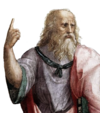
Back Ideëleer Afrikaans نظرية المثل Arabic Теория за формите Bulgarian تیۆریی فۆرمەکان CKB Ideenlehre German Θεωρία των μορφών Greek Teoría de las formas Spanish Ideien teoria Basque نظریه اشکال Persian Ideaoppi Finnish
In philosophy and specifically metaphysics, the theory of Forms, theory of Ideas,[1][2][3] Platonic idealism, or Platonic realism is a theory widely credited to the Classical Greek philosopher Plato. The theory suggests that the physical world is not as real or true as "Forms". According to this theory, Forms—conventionally capitalized and also commonly translated as "Ideas"[4]—are the non-physical, timeless, absolute, and unchangeable essences of all things, of which objects and matter in the physical world are merely imitations. Plato speaks of these entities only through the characters (primarily Socrates) in his dialogues who sometimes suggest that these Forms are the only objects of study that can provide knowledge.[5]
Scriptures from Pythagoras suggest that he developed a similar theory earlier than Plato, with Pythagoras's theory specifically proposing that the world is entirely composed of numbers. The early Greek concept of form precedes attested philosophical usage and is represented by a number of words mainly having to do with vision, sight, and appearance. Plato uses these aspects of sight and appearance from the early Greek concept in his dialogues to explain his Forms, including the Form of the Good. The theory itself is contested by characters within Plato's dialogues, and the theory remains a general point of controversy in philosophy. Nonetheless, it is considered to be a classical solution to the problem of universals.[6]
- ^ Modern English textbooks and translations prefer "theory of Form" to "theory of Ideas", but the latter has a long and respected tradition starting with Cicero and continuing in German philosophy until present, and some English philosophers prefer this in English too. See W. D. Ross, Plato's Theory of Ideas (1951)
- ^ The name of this aspect of Plato's thought is not modern and has not been extracted from certain dialogues by modern scholars. However, it is attributed to Plato without any direct textual evidence that Plato himself holds the views of the speakers of the dialogues. The term was used at least as early as Diogenes Laërtius, who called it (Plato's) "Theory of Ideas:" Πλάτων ἐν τῇ περὶ τῶν ἰδεῶν ὑπολήψει..., "Plato". Lives of Eminent Philosophers. Vol. Book III. p. Paragraph 15.
- ^ Plato uses many different words for what is traditionally called Form in English translations and Idea in German and Latin translations (Cicero). These include idéa, morphē, eîdos, and parádeigma, but also génos, phýsis, and ousía. He also uses expressions such as to x auto, "the x itself" or kath' auto "in itself". See Christian Schäfer: Idee/Form/Gestalt/Wesen, in Platon-Lexikon, Darmstadt 2007, p. 157.
- ^ "Chapter 28: Form" of The Great Ideas: A Syntopicon of Great Books of the Western World (Vol. II). Encyclopædia Britannica (1952), pp. 526–542. This source states that Form or Idea get capitalized according to this convention when they refer "to that which is separate from the characteristics of material things and from the ideas in our mind."
- ^ Watt, Stephen (1997). "Introduction: The Theory of Forms (Books 5–9)". Plato: Republic. London: Wordsworth Editions. pp. xiv–xvi. ISBN 1-85326-483-0.
- ^ Kraut, Richard (2017), "Plato", in Zalta, Edward N. (ed.), The Stanford Encyclopedia of Philosophy (Fall 2017 ed.), Metaphysics Research Lab, Stanford University, retrieved 2021-05-20
